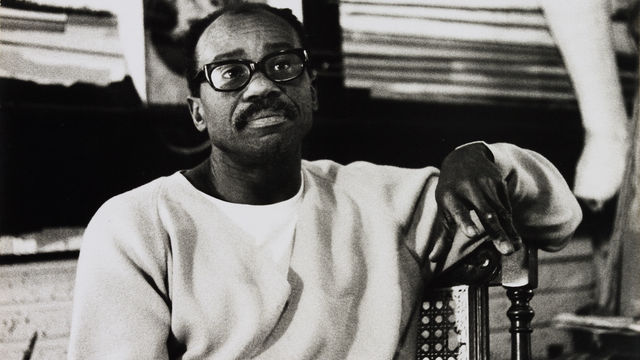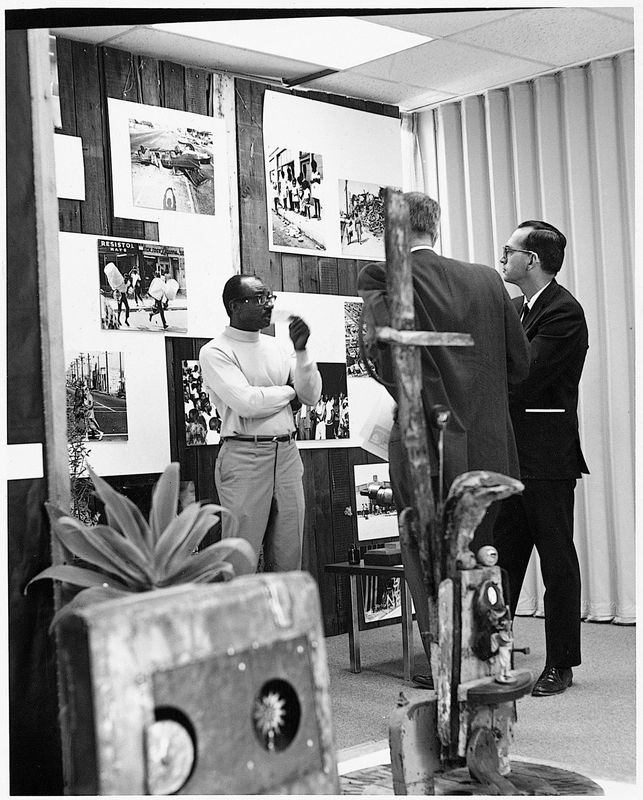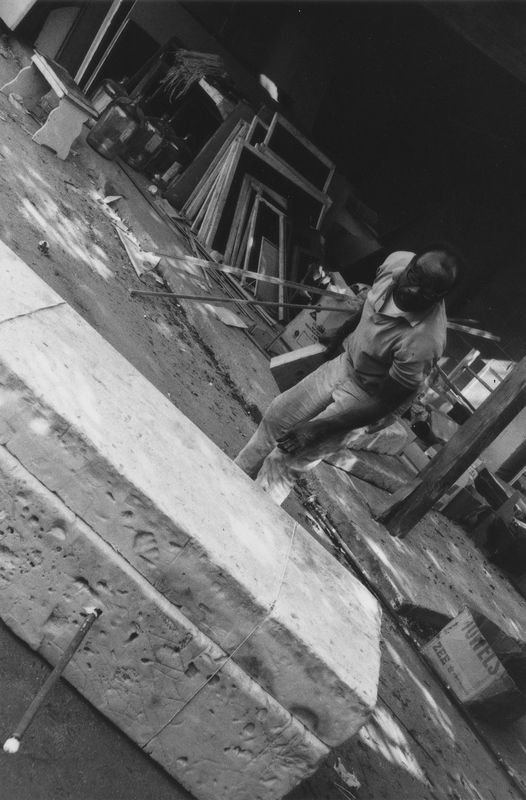
Noah Purifoy
Born in rural Alabama, Noah Purifoy moved to Birmingham when he was five, at a time when racism was a harsh and visible reality. He received a bachelor's degree in social science from Alabama State Teacher's College in Montgomery in 1939 and taught wood shop at a Tuscaloosa high school for the next three years. Purifoy then enlisted in the U.S. Navy and after his discharge in 1946 attended Atlanta University, receiving a master's degree in social work in 1948. He moved to Los Angeles in 1950 and enrolled at Chouinard Art Institute a year later, receiving a BFA in 1954. His training as a social worker and his own experiences growing up in the South led Purifoy to be committed as an artist to addressing the social and political concerns of the black community. He cofounded the Watts Towers Arts Center in 1964 with Judson Powell and Sue Welsh, serving as its first director. One of the first of its kind in California, the center provided opportunities in the arts for both artists and community residents.
The eruption of the Watts rebellion a year after the center's opening changed Purifoy's artistic vision as he moved toward assemblage and a more obviously socially charged aesthetic. The debris from the riot served as material for Purifoy, whose work explores the relationships between Dada assemblage practices, African sculptural traditions, and black folk art. Once the products of industrial and consumer culture, the rubble became art through its recontextualization by residents of Watts. Purifoy collaborated with other artists to create 66 Signs of Neon, a collective work consisting of sixty-six individual assemblages made from the wreckage. The exhibition traveled nationally and internationally, serving as a voice for a community left scarred, both physically and emotionally, by the violence. In 66 Signs of Neon, the use of materials such as melted neon signs created beauty from ugliness, not only of the objects themselves but also of the society from which they came. The viewer is forced to question how the debris ended up as such, prompting a level of social consciousness and, at least to some degree, a feeling of complicity.

Experimenting with the abstract and the everyday, Purifoy has left an indelible mark on contemporary West Coast art. For him, art was a way to reflect on relationships and on life, to communicate experience through a medium that allows for change and fluctuations. Through assemblages that are often architectural in form, he celebrated abstraction for its ability to evoke multiple responses and to make keen observations on social conditions. Society's refuse became the anchor of his sculptures. Instead of celebrating industry, he pointed to the problems inherent in consumerism: waste and neglect. Found objects, often banal and ruined, comment not just on their materiality but also on their social and political essence. The rusted metal, cracked glass, and charred wood all contain their own histories, imbuing the works with stories of urban life and struggle that spur conversation and effect change in the viewer.
Purifoy's works are rich with myriad influences and inspirations. Commentaries on social conditions, the art world, and humanity itself come together in abstract forms that refer to multiple sculptural traditions, from ancient African masks to contemporary art practices. Color and texture, often brought about by the use of oxidized and rusted metals, create visually varied surfaces that demonstrate stunning workmanship. The juxtaposition of rough edges with smooth surfaces and flat planes with rounded objects produces a poetic rhythm that recalls the ideas of chance and improvisation in jazz.

In 1976, tired of art-world politics and dismayed by the disappearance of the community-based art programs that had flourished in the 1960s, Purifoy accepted a position on the California Arts Council. For the next eleven years he helped design and fund new art programs for the state, several of which are still in operation today. He moved to Joshua Tree, California, in 1989 to resume his own art practice, finding new inspiration in the expansive desert. Civic minded in both his artistic and social practice, Purifoy established an outdoor art museum to display his assemblages. There, exposed to the erosive effects of time and weather, his works continue to comment on the political and cultural circumstances that affect not only his materials but also society as a whole.
—Connie H. Choi
Selected Exhibitions
66 Signs of Neon, Simon Rodia Commemorative Watts Renaissance of the Arts Festival, Los Angeles, 1966; traveled through 1969.
Microcosm 69, Long Beach Museum of Art, 1969.
Environmental Experience, Brockman Gallery, Los Angeles, 1971.
Five: Benny, Bernie, Betye, Noah & John, Lang Art Gallery, Scripps College, Claremont, California, 1971.
Contemporary Black Artists in America, Whitney Museum of American Art, New York, 1971.
Los Angeles 1972: A Panorama of Black Artists, Los Angeles County Museum of Art, 1972.
Noah Purifoy: Outside and in the Open, California African American Museum, Los Angeles, 1997.
Selected Bibliography
Chattopadhyay, Collette. "Improvisation and Assemblage: Noah Purifoy Explores Contradictions and Cultures." Sculpture, July–August 1997, 31–39.
Lewis, Samella S., and Ruth G. Waddy. "Noah Purifoy." In Black Artists on Art, 2:68–70. Los Angeles: Contemporary Crafts, 1976.
Purifoy, Noah, interview by Karen Anne Mason, 1990. African American Artists of Los Angeles, Oral History Program, University of California, Los Angeles. Transcript, Charles E. Young Research Library, Department of Special Collections, UCLA.
Purifoy, Noah, and Ted Michel. Junk Art: 66 Signs of Neon. Exh. cat. Los Angeles: Watts Art Festival, 1966.
Secunda, Arthur. "The ‘Junk’ of Watts." Arts Magazine 41 (February 1967): 49–51.
Tarbell, Melinda. "Los Angeles." Arts Magazine 45 (May 1971): 48.
Selected Links
Noah Purifoy Foundation website.
Watts Towers Arts Center website.
Noah Purifoy biography page, Pacific Standard Time at the Getty Center, Los Angeles.
Noah Purifoy Wikipedia page.
"Noah Purifoy: Art as Elegant Wreckage," The Tavis Smiley Show, March 17, 2004.
Carolina Miranda, "Noah Purifoy, an Artist Forged by Fire," Los Angeles Times, August 13, 2015.
Chandra Frank, "Noah Purifoy and Migrating Assemblages," Warscapes, February 15, 2016.

